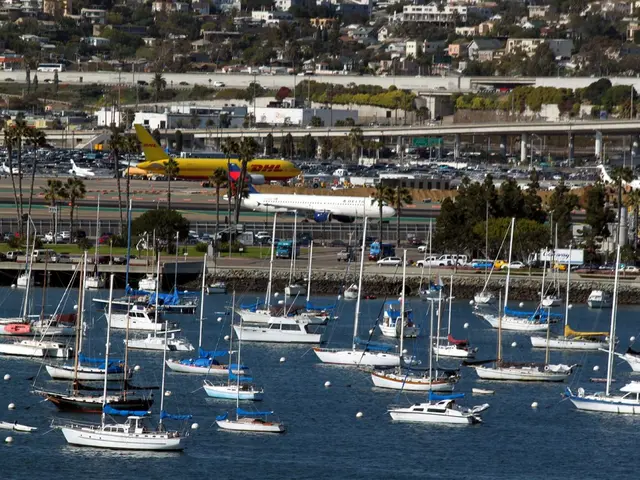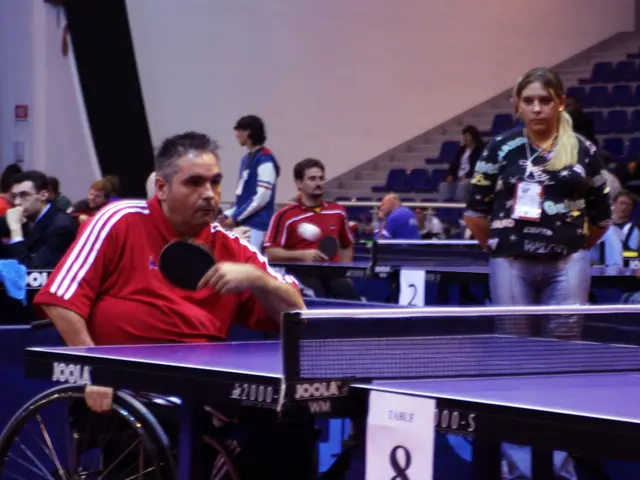Transforming Pedestrian Momentum into Policy: Rotterdam's Success Story
Revamped Tale:
Hanging out with urban planning pals and dreaming big for the city you love - that was the setup for José Besselink, a Rotterdam urban planner, in El Rosario, Argentina, back in 2016. Gil Penãlosa, at the Happy Cities Festival, shared the vision of 8 80 cities, where the elderly and youngsters alike thrive, and José couldn't help but feel that her hometown needed to follow this blueprint. Little did she know that her journey towards making Rotterdam a city for the people was about to begin.
Fast forward to 2020, and Rotterdam had its own walking strategy, dubbed Rotterdam Walks 2125. This action plan provides a roadmap for transforming the city into a paradise for pedestrians, taking the reader through the lessons learned from hosting the Walk21 conference in 2019, listening to citizens' input, the dream of a stroll through Rotterdam in 2125, and a rundown of the current state of affairs and future prospects. What are the lessons learned, and what are the key takeaways?
Here's a simple cheat-sheet on how to do it Rotterdam's way:
Embracing Outside Influences to Advocate Inside
"At first, I was operating like a lone wolf," confesses José. Over a period, she gradually seeded her ideas: She recommended Gil Peñalosa as a keynote speaker for the Dutch Mobility Matters Conference in 2017, organized site visits and meetings with him and key players in the city, along with placing focus on the Rotterdam Mobility Approach and the Vision on Public Space. The timing was perfect when she met Jim Walker from Walk21 later that year, and the city of Rotterdam hosting the Walk21 annual conference in 2019 was the result.
"You can't host a walking conference without showing some kick-ass examples first," says José bluntly, explaining how hosting Walk21 opened doors. "Inviting an expert from outside your organization who is well-versed in a particular topic can help convince the organization to set the stage," she continues. Sometimes, it's less about bringing in fresh perspectives; instead, it's all about giving new voices the chance to speak who share the same vision as you. "It's the famous names that carry a lot of weight and clout within the urban planning network," José wisely points out.
In the case of Rotterdam, hosting Walk21 proved to be the catalyst for their walking strategy. Not only did it offer inspiration, but it also brought together a passionate team advocating for walking and striving for implementation and policymaking once Walk21 ended. To make sure that the conference's legacy wouldn't simply vanish, Rotterdam made full use of that momentum and enthusiasm, installing a program manager and action plan coordinator to drive the creation and execution of the city's walking strategy - with an interdepartmental team representing mobility, health, maintenance, safety, sports, and accessibility departments.
"From embarking on this solo fight with just one colleague, I've now become part of a full-fledged program team," José proudly concludes.
Collaboration, Engagement, and Interconnection: Ensure Pedestrian Trails Stick
While walking may seem glaringly obvious, pushing for it politically requires that explicit steps be taken.
Tactically speaking, a walking strategy can serve as a cornerstone, offering a framework to justify investments, setting targets, and implementing changes on a policy and street level. It is crucial to anchor walking's apparent obviousness at both political and strategic levels.
What's noteworthy about Rotterdam's project is how successfully it interlinks walkability across departments: The many facets walkability encompasses go beyond the mobility and urban planning realm. Rotterdam's walking strategy is closely related to their spatial planning and environmental strategy, the Rotterdam Mobility Approach, the Vision on Public Space, the Healthy 010 Strategy, the Safety Strategy, and various policy documents addressing topics such as clean air, noise, climate change, accessibility, and cycling.
Linking the walking strategy to all the other city programs and visions add weight and impact to the topic, offering a plethora of perspectives and potentially opening up new funding sources. That is how to transform walking from an evident necessity into an essential intersectional subject that boosts your city's livability.
This symbiosis is also reflected in Rotterdam's walking program team, which draws from diverse departments such as urban planning, mobility, public health, property management, public safety, sports, social development, and accessibility. Even if interdepartmental collaboration might not be usual for your city, push for such an integrative approach, break through departmental barriers, and work as a team for a topic that pierces beyond departmental affiliation – each department will undoubtedly gain from knowledge exchange and connect it back to their other responsibilities.
Grant Citizens a Voice, Experiment, and Empower Community Leaders
Creating a city designed for people means listening to your citizens' voices first. Rotterdam began by engaging with their city panel through a survey (1,900 respondents) and a campaign, asking citizens why they walk or don't walk, what amount of time walking is acceptable when traveling, and where they do and don't prefer walking. With the results from the "Will you walk with me" campaign, the city created a map of Rotterdam adorned with hearts and broken hearts, identifying the areas requiring improvements in pedestrian friendliness (see pages 11 and 12 in the strategy).
When it comes to persuading entrepreneurs and neighbors of changes in street design, be aware of the objections they might present, and work with the tools available: Rotterdam always handpicks a project manager responsible for community participation and engagement when redesigning a street, and they work alongside those already sold on the idea - letting them spread the word instead of pushing it themselves.
To generate more awareness and drive behavioural shifts, the city also collaborates with local ambassadors – community leaders who are active walkers and have incorporated walking into their lifestyles. "The primary challenges we're tackling now are behavioral changes," José candidly admits. "It involves informing people about health and walking benefits, in addition to investments in public spaces. It's about connecting these investments to a social movement and behavioral change by engaging with communities and people." This way, community knowledge flows back to city policies.
Moreover, the city regards experiments and pilots as valuable in conveying their message and vision: "We've launched a tactical intervention program to show the community what the city of the future could look like, through parklets or facilitating several trials where we provided temporary space for pedestrians." From a communication perspective, Rotterdam began sharing before-and-after images on social media, finding that "as soon as we redesigned a street, people quickly forgot about its previous state. We want to remind people about the city evolving."
Feeling curious? Check out a collection of before-and-after images here.
Focus on Data and Craft a Walking Network
At the outset, data on pedestrian traffic was partly absent in Rotterdam, as José points out: "We know everything about car mobility, public transport, and cycling from the past decade, but data on walking was lacking." Collecting the required data is now part of Rotterdam's action plan: Merging different data sets into GIS layers, incorporating community feedback, and making this data available to designers working in the area helps them comprehend citizens' main concerns and priorities.
For all other modes of transport, such as cycling or public transport, a clearly delineated route network exists – all the more reason for Rotterdam to develop an urban pedestrian network as well. Through this network, along with the positioning of street typology, a toolkit with pedestrian design principles is being developed. This guide isn't only for designers but also for handbooks and guidelines for accessible public spaces and design principles for networks of other transport modes.
Focus on Policy, Pilots, and Policy
When asked about advice on how to advance walking in cities that haven't progressed as much as Rotterdam, José underscores the role of policy: "In the beginning, I'd say policy is crucial. It may be hard if people aren't yet on board – it takes a giant leap from nothing to creating policy. Start with experiments and pilots to demonstrate the city of tomorrow's potential and try to incorporate those insights back into policy-making."
She strongly advocates an integrated approach, as it will only boost your message's strength and force – involve local communities and link back their expertise to the policy-level too. José emphasizes the holistic idea of networking: "Map out a network, engage as many people as possible, and regard network building as a way of working" to emphasize the topic's significance in the city.
The Bottom Line
In summary, these are the elements from Rotterdam's success story when it comes to elevating pedestrians:
- Welcome external expertise to fuel the issue's growth within your organization
- Opt for an integrated approach, embracing it in both team dynamics and strategy execution
- Empower citizens and persuade them through experiments and community leaders
- Focus on data management, construct a walking network, and link everything back to urban designers
- Policy, pilots, policy: Establish a policy framework, utilize pilot projects to influence policymaking
[References]
[1] Knaap, W., Mooij, P., Okkerse, A., & Verheijen, L. A. (2019). Creating sustainability in historical city centers: The Centre or the City. Local Environment, 24(3), 291-305.
[2] Božić, D., Božić, S., & Stojkić, Z. (2018). Non-motorized transport in cities in Serbia, Montenegro, and Bosnia and Herzegovina: Policy, infrastructure, and current state of affairs. Sustainable Cities and Society, 41, 570-583.
[3] Kivanen, A., Vaahto, M., Vuori, M., Sarantakos, S., & Zografou, E. (2019). Transforming mobility systems: Upscaling innovative mobility solutions. Journal of Cleaner Production, 202, 163-174.
[4] Wuilloud, M., & Yvergniaux, I. (2019). Sustainable landscapes of the smart city: Urbanizing green infrastructure for resilience in the Anthropocene. Landscape and Urban Planning, 182, 69-80.
[5] Li, Y., Mattoon, C., & Turner, E. (2019). Smart and sustainable cities: An integrative framework and an interdisciplinary perspective. Sustainability, 11(1), 1-27.
- José Besselink, a Rotterdam urban planner, found inspiration in the vision of 8 80 cities, advocating for making Rotterdam more pedestrian-friendly.
- In 2017, José recommended Gil Peñalosa as a keynote speaker for the Dutch Mobility Matters Conference, seeding her ideas about walkable cities.
- Hosting the Walk21 annual conference in 2019, which José made possible, opened doors for Rotterdam's walking strategy.
- Rotterdam's walking strategy, Rotterdam Walks 2125, offers a framework for transforming the city into a paradise for pedestrians.
- The walking strategy is closely related to Rotterdam's spatial planning and environmental strategy, the Rotterdam Mobility Approach, and the Vision on Public Space.
- José emphasizes the importance of inviting experts from outside the organization to help convince it to set the stage for walking infrastructure.
- Rotterdam stationed a program manager and action plan coordinator to drive the creation and execution of the walking strategy.
- The city's walking strategy team draws from multiple departments, including urban planning, mobility, public health, property management, public safety, sports, social development, and accessibility.
- To engage citizens, Rotterdam began by conducting a survey and a campaign, asking citizens why they walk or don't walk.
- Rotterdam created a map of the city, adorned with hearts and broken hearts, based on the results from the "Will you walk with me" campaign.
- The city collaborates with local ambassadors to drive behavioral shifts and boost the city's livability.
- Rotterdam always handpicks a project manager responsible for community participation and engagement when redesigning a street.
- Rotterdam shares before-and-after images on social media to generate more awareness and drive behavioral changes.
- Data on pedestrian traffic was lacking in Rotterdam initially.
- Collecting data on walking is now part of Rotterdam's action plan.
- Rotterdam is developing an urban pedestrian network, analogous to the route network for cycling and public transport.
- A toolkit with pedestrian design principles is being developed based on the urban pedestrian network.
- Policy is crucial for advancing walking in cities.
- Start with experiments and pilots to demonstrate the city of tomorrow's potential and try to incorporate those insights back into policy-making.
- Involve local communities and link back their expertise to the policy-level for a holistic approach.
- Map out a network and regard network building as a way of working to emphasize the topic's significance.
- Embracing outside influences to advocate inside is a key lesson from Rotterdam's success story.
- José began her journey towards making Rotterdam a city for the people, with just one colleague initially.
- Rotterdam's walking strategy has boosted the city's livability, transforming walking from an evident necessity into an essential intersectional subject.
- Giving new voices the chance to speak who share the same vision as you can help drive change.
- Rotterdam's walking strategy has opened up new funding sources due to its symbiosis with other city programs and visions.
- Rotterdam's walking strategy serves as a cornerstone, offering a framework to justify investments, setting targets, and implementing changes on a policy and street level.








